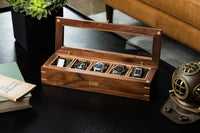Sure, Analog:Shift is a business built around the love of watches — mainly mechanical watches. But, in essence, it’s our love for timepieces and timekeeping in general that are the common themes throughout the items we procure. And that includes the love of clocks in general: pocket watches, travel clocks, and more.
After all, in the couple hundred years before the First World War, personal timekeeping was all about the pocket watch, and before that, it was larger clocks that were front and center, horologically. We still believe a good clock — such as a classic travel model from the mid century — has a proper place in a watch lover’s collection.
You needn’t picture clock collecting as the stuffy domain of generations past, or the sole purview of an introvert surrounded by noisy cuckoo clocks or incessantly chiming grandfather clocks. (Though, to be fair, we’re non-denominational horologists, here, and fully supportive of both of those clock categories.) No: clock collecting today can — and should — mirror watch collecting, and there are plenty of distinct categories of clock that bring to mind the beauty, sophistication, and elegance of beloved and classic wristwatches. Let’s take a look at some of them, shall we?
Pocket Watches

Patek Philippe Pocket Watch ref. 980G-001 circa 2000s
Until the First World War, the pocket watch was the gentleman’s preferred mode of timekeeping, and primary accessory. Secured by a chain and held in his waistcoat pocket, the pocket watch was eclipsed by the wristwatch in popularity due only to the necessity of having both of one’s hands free while soldiering — and then, only reluctantly. Today, a good pocket watch offers everything we love about wristwatches, only larger: A larger (often porcelain) dial to appreciate; a larger movement to scrutinize, often beautifully finished; and a larger case. If you find one you absolutely love but don’t fancy carrying it around, consider parking it on a wooden stand on your desk made for just such a purpose.
Travel Clocks

Cartier Must De Cartier Travel Alarm Clock circa 1980s
Small mechanical travel clocks make for wonderful desk paraphernalia and beautiful gifts. Beginning in the inter-War period, we begin to see wildly cool, compact, well designed clocks specifically meant for accompanying their owners on the road. These sometimes took the form of collapsible timepieces that could be opened and placed on a nightstand — such as the famous Movado Ermeto — and featured a case made of silver, or possibly covered in an exotic leather such as stingray.

Jaeger-LeCoultre Memovox Travel Alarm Clock circa 1950's IN THE SHOP
In the 1950s, they took on larger, more conventional square forms that are equally neat, albeit perhaps without some of the panache of the 1930s-variety models. (And thankfully, without the use of stingray — leave those alone and in the ocean.)
Weather Stations

Angelus Globe Clock & Weather Station circa 1960s
Before there was a television in every home — and well before there was this thing called “the internet” — there were weather stations, desktop or wall-mounted instruments that would give information such as temperature, barometric pressure, the time, and possibly a tide graph.

These beautifully made instruments can still be found on the secondary market today — provided one knows where to look — and those that are made of wood or brass make for exquisite accessories to a thoughtful watch collection. Sometimes, it’s even possible to find one produced by a notable watch company such as Angelus. Our vote? Find one with a built-in clock.
Desk Clocks

Jaeger 'Birthday' Desk Clock - IN THE SHOP
Many important watch brands made desk clocks in the mid-20th century, perhaps most notably Jaeger-LeCoultre and Omega. These clocks could take many forms, from more conventional rectangular shapes to the Art Deco-inspired, pyramidal masterpieces in exotic materials such as lapis lazuli.

Jaeger-LeCoultre 8-Day Table Clock circa 1940s IN THE SHOP

Omega Table Clock Chronometer circa 1930s IN THE SHOP
Indeed, the Art Deco period was a fabulous time for horology in general, having resulted in some of the most fetching desk clocks (and pocket watches, and travel clocks) of the 20th century. These days, a vintage desk clock can completely change the feel of a room; set one up on a bookshelf, desk, or dresser for a nod to the bygone days of the 1940s or 1950s.
Stopwatches
 Junghans 1/10 Second Stopwatch circa 1960s
Junghans 1/10 Second Stopwatch circa 1960s
During the 20th century, before digital clocks were fixtures in gyms and racetracks everywhere, handheld stopwatches were the preferred mode of sport timing. (Indeed, when Omega first timed the Olympics in Los Angeles in 1932, it was with crates of stopwatches.) Made by the likes of Heuer, Omega, and others, these stopwatches still come in handy today — though they admittedly take a back seat to the efficiency and accuracy of smartphones. Rather, these mechanical marvels serve today as fun accessories and reminders of a horological past about which we watch lovers reminisce wistfully…the irony being that many of us were admittedly too young to have ever used handheld stopwatches in gym class!













